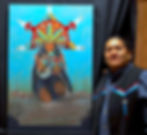The storytellers, wisdom keepers, and healers have carried cultural knowledge from generation to generation. Those who pass forward the accumulated wisdom of experience help us make sense of the world in which we live. In the land of the Hopi, one of the ancient teachings is to "Work hard, keep the ceremonies, live peaceably, and unite your hearts.” These words guide the life journey of Hopi artist Filmer (Yoimasa) Kewanyama. Fil began his walk on the path in Hopi land, Second Mesa, Arizona. He learned his way from watching his parents, relatives, and village elders thru the ceremonies of culture. It is believed the art of storytelling, music, song, ceremonial dress, and dance is the foundation for understanding who and what you are with the Earth and its elements.

As a young man, Fil chose the U.S. Army as his career path; he served on active duty for 21 years, retiring at the rank of First Sergeant in an Infantry Rifle Company. Upon retiring from the country's service, Fil spent several years as a federal security officer for federal buildings in Arizona. Ultimately in 2004, he chose to walk a new path creating the next chapter of his journey. He readily admits, “The transition from military to civilian life was not a smooth road. I’ve had to deal with adjusting to civilian life. I received help thru Veteran’s Health for active-duty related injuries.” Fil enrolled in Yavapai College, Prescott completing his Associate's Degree in Graphic Design. Moving along the creative spiritual path Fil is now firmly committed to his Hopi art. He explains, "It is my way of telling my story of who we are as Hopi. I mostly work in acrylics but have also studied oils, watercolors, clay sculpting, mixed-media, and digital art.”

Today Fil works from his home studio in Prescott. The majority of his work depicts and chronicles the Hopi way of life. He explains, "We Hopi are the few Native American people who cling to our old way of life and its ceremonies. The usage of symbols and what I call Katsina colors is crucial to my work. My influences are from what I know of Hopi history, my interpretations, fueled by my own experiences and feelings." Fil's focus is on the spirituality of the Hopi, The People of Peace. He has demonstrated this in a variety of projects throughout his artistic career.

Fil won an award through the Veterans Art competition for an acrylic painting of the Hopi Code Talkers. Although the Navajo tribe is most remembered for its contributions to the World War II communications code units, the Hopi tribe also helped in the communications coding efforts. Eleven Hopi men developed a code language that they used to assist U.S. Army intelligence in the Marshall Islands, New Caledonia, and the Philippines during the Second World War. Fil's brought attention to these brave heroes. He also painted two large murals, one at the Verde Valley Archaeology Center on the emergence story of the Hopi people and another at the Museum of Indigenous People stressing the importance of the sacredness of water.
"We Hopi are the few Native American people who cling to our old way of life and its ceremonies. The usage of symbols and what I call Katsina colors is crucial to my work."

Fil metaphorically dances in several areas in his mission to connect and educate others on the Hopi culture. Seasonally, he works with the Road Scholar Program, Boston, Massachusetts, with tours throughout the Southwest. The tours visit the Hopi/Navajo lands and Chaco Canyon, New Mexico. He curates the exhibit "Journeys in Spirit" for Tis Art Center & Galleryhe is also a member of the Board of Directors. He participates annually in the Native American exhibit at the Phippen Museum, the Prescott Studio Tour, and the National Veteran's Creative Arts Festival in Prescott. Filmer (Yoimasa) Kewanyama's work is represented by Cactus Wren Art Gallery in Tubac, Arizona, and he exhibits from his 6th Street Business Park studio in Prescott. He also provides art presentations on his works and the history of the Hopi people to groups throughout the community. In many ways, he walks in the form of "Wisdom comes only when you stop looking for it and start living the life the Creator intended for you.”
Email: yoimasa@gmail.com
Website: yoimasa.carbonmade.com

